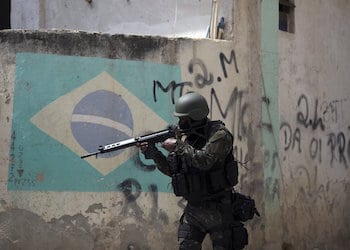Organized crime groups use violence to manipulate elections in Mexico and Brazil, a new report has revealed. But surprisingly, some parts of Mexico that are most afflicted by organized crime suffered few attacks against local officials.
The report by the Armed Conflict Location and Event Data Project (ACLED) published June 22 tracked violence against local government officials in around 100 countries, including in-depth case studies on Mexico, Brazil, and four other countries.
Both Latin American countries surpassed the global average of intentional attacks against government officials that resulted in death or injury, the report said. In Mexico and Brazil, 62% of attacks were defined as “direct,” which included acts like shootings or beatings, compared to 50% at a global level. Non-direct attacks, including riots, accounted for the rest.
Organized crime groups can influence elections by increasing violence, thereby lowering turnout and protecting incumbent candidates with whom they have agreements. They have also used violence to intimidate poll workers and have killed candidates they see as a threat to their interests.
Globally, armed political conflict was a common driver of violence against officials. But outside of war zones, organized crime was a common culprit, with some exceptions.
InSight Crime Analysis
Organized crime groups often increase violence against politicians in the run-up to elections, the report found. But in some regions of Mexico with a particularly strong organized crime presence, groups may wield so much power that violence is no longer necessary for coercion.
For example, the state of Baja California, which borders the United States, has been one of Mexico’s bloodiest states as a result of powerful groups fighting to control criminal economies. But despite the generalized violence there, ACLED registered few instances of violence against local officials, even during elections. The data showed a similar pattern in Nuevo León, another criminally active state near the border.
Broadly speaking, though, Mexico has experienced a sharp uptick in political violence in the run-up to elections. About half of the violence leading up to the 2018 general elections was directly attributed to organized crime. During that time political figures were killed at a rate of one per week.
SEE ALSO: Why Have Political Assassinations More Than Doubled in Brazil?
But organized crime groups may be responsible for an even larger proportion of the violence, Sandra Pellegrini, a Latin America Regional Specialist at ACLED, told InSight Crime. Much of the unattributed violence was committed by unidentified armed groups that could not be conclusively identified as an organized crime group.
“It’s quite difficult, in Mexico, to attribute violence to specific groups, so … we’re not necessarily able to identify who is the perpetrator of the violence,” Pellegrini said.
Violence was even worse in 2021, with estimates of up to 150 people were killed in election-related incidents.
Brazil also saw the largest spikes in violence against officials in the run-up to elections, the report found. However, in contrast to Mexico, higher rates of political violence in Brazil were clearly connected to areas with a history of organized crime.
Gangs led by law enforcement and other officials, known as militias, commit the most political violence, the report found.
“In the case of violence targeting local officials and politicians, there is a heavy involvement of police militias due to their close proximity with state agents,” Julia Lins Franciotti, South America Research Manager at ACLED, told InSight Crime.
One police militia, the Escritório do Crime, was linked to the 2018 murder of Marielle Franco, a councilwoman and strong opponent of federal policing in Rio de Janeiro’s poorest neighborhoods. Though her case remains unsolved, two former police officers were arrested.
Criminal groups including the First Capital Command (Primeiro Comando da Capital – PCC) and the Red Command (Comando Vermelho – CV) also committed significant amounts of violence against local officials, according to the report. In their strongholds of São Paulo and Rio de Janeiro, as well as in other regions, these groups build networks with local politicians and use violence against their opponents. The PCC in particular has targeted officials in response to new security policies aimed at curtailing the gang’s operations.

